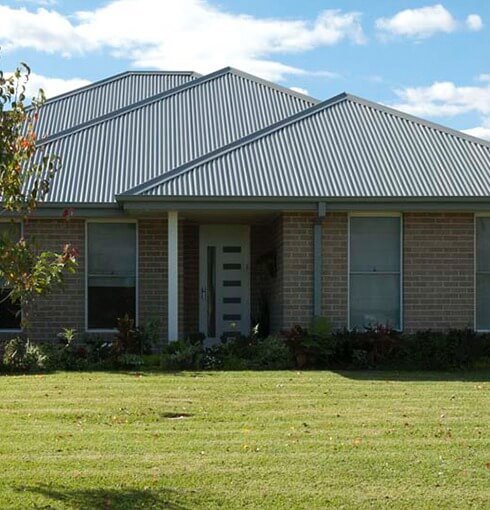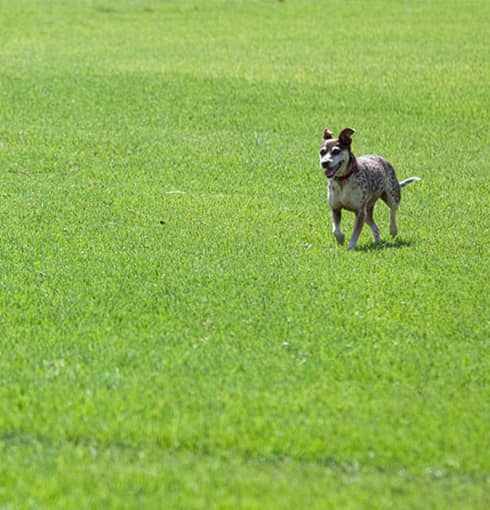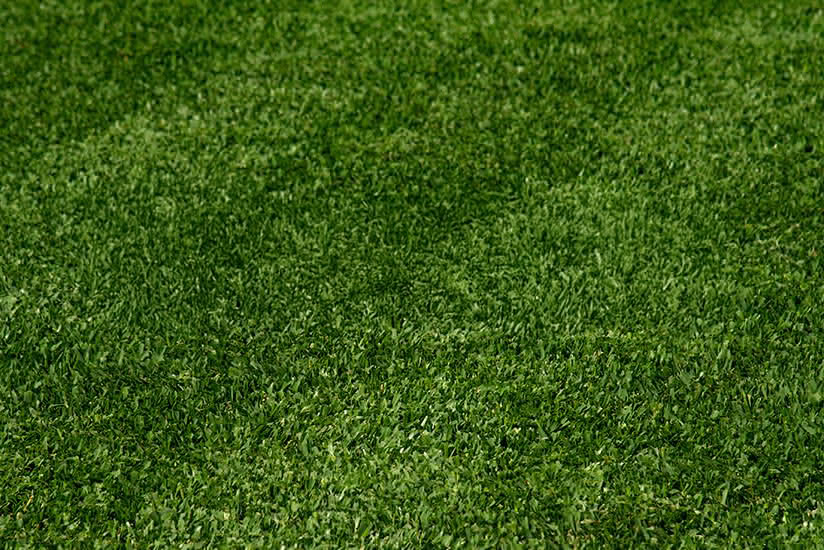ANTHRACNOSE
This disease is especially prevalent during warm, humid weather. The irregular shaped patches of infected areas are reddish-brown turning to yellow and tan. Younger leaves are quite often red. Treat with an approved fungicide.

BROWN PATCH
Brown Patch is a disease of summer and early autumn when the weather is cool and wet. The characteristic of the brown patch is the “smoke ring” with the disease. This ring of dark grey (fungus mycelium) often surrounds the infected area but disappears as the foliage dries. It is not always present. The affected areas may grow up to one metre in diameter. It does occur in all mainland states and is widespread in NSW. Treat with an approved fungicide.
DOLLAR SPOT
The disease name comes from the dead straw-coloured spots about the size of a dollar. Dollar spot may persist from early summer until early autumn. It appears to be more prevalent in seasons with low rainfall, presumably from the adverse effect of low soil moisture on the grass. Treat with an approved fungicide.
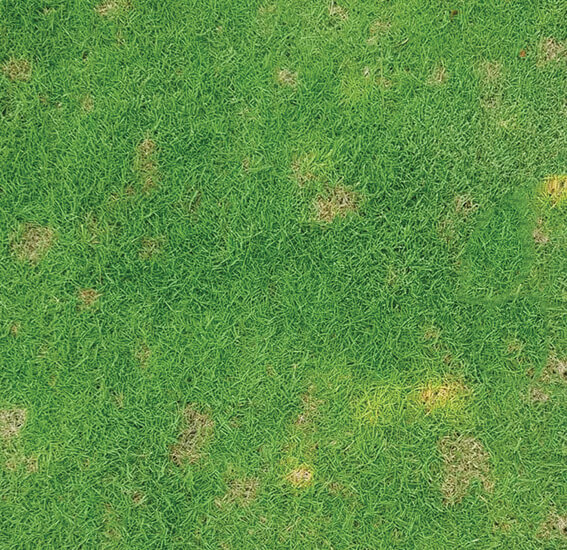
Pythium/Damping Off
This disease is prevalent in hot, humid weather and where there are poor drainage and air circulation. The patches of infection enlarge at a rapid rate
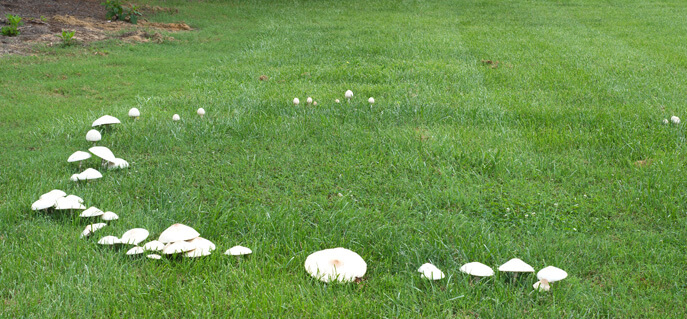
FAIRY RING
During the spring or summer, a circle or arc of stimulated grass or toadstools may appear in lawns. These are called fairy rings. The rings can vary in size from a few centimetres to 20 metres in diameter. These rings of lush growth in the lawn are caused by the release of nutrients, in particular nitrogen, from the activity of the fungus living on organic matter in the soil. The hydrophobic nature of the soil profile needs to be reversed using wetting agents and then the use of an appropriate fungicide.
Winter Fusarium
This is a common disease found in the colder months on the cool season fine grasses used in bowling and golf greens. Circular patches appear as small water-soaked spots less than 5cm in diameter. Soils that are high in nitrogen and low in phosphorous and potassium favour this disease. To fix this, balance fertility and soil pH to increase air circulation.

Helminthosporium Leaf Spot
Can occur at any time of the year when there is a lot of moisture around and not much wind to dry the grasses. This causes small lesions on the leaf blades.
Red thread
Dead leaves interspersed with uninfected leaves is one of the first symptoms. Red thread commonly appears in spring and autumn during humid periods and is especially severe on slow-growing nitrogen-deficient lawns. Another noticeable symptom is the water-soaked patches of grass in the spring. Infected grass blades soon die and fade to a bleach tan colour when dry.

Take All Patch
Take All Patch is mainly active in cool, wet years and poorly drained soil. The first symptom is a yellowing of the leaves and a darkening of the roots. Small, light brown dead patches appear and then continually spread. During winter the affected areas turn grey.
Rolf’s Disease
Rolf Disease generally occurs in the warm conditions of spring and summer. It comes up in circular areas of 15-45cm diameter, appearing with rings of dead grass.

SPRING DEAD SPOT
This disease favours cool, wet weather in spring and autumn with daily temperatures of less than 15C. It appears as circular areas of dead grass, 15-30cm in diameter when turf resumes growth in spring. This is more severe on mature turf and in areas with long winters and cold temperatures.
* Turfgrass Disease Management M.L.Elliot and G.W.Simone edis.ifas.ufl.edu/topic_turf_diseases
Turf Varieties we Supply
Our grass selection is 100% genuine and tailored to fit every need, whether you’re sourcing turf for residential projects, trade, or commercial applications. Our turf supplies ensure the perfect solution for every space.
Sir Walter DNA Certified Turf
$15.00 per m2Locally grown and produced, Sir Walter DNA Certified turf is a variety that has proven to grow in the most extreme weather conditions- hot or cold. Extremely low maintenance, you’ll undoubtedly love this buffalo variety.
TifTuf Bermuda Turf
$15.00 per m2Almost 25 years of research has produced Tif Tuf Bermuda Turf, a resilient and beautiful grass that is made to last. With incredibly high wear and weather tolerance, this grass is perfect for high traffic areas.
Sir Grange Turf
$25.00 per m2A successful product from turf grass breeders, Sir Grange Zoysia is made to please. Initially created for golf courses, this manicured grass is an outstanding performer that will survive those harsh Australian droughts.
Zoysia Australis Turf
$15.00 per m2Zoysia Australis is a tough and hardy, medium-textured Zoysia japonica with a beautiful blue/green leaf. It’s a new Zoysia variety that provides solutions for Aussie families with its ability to be installed in a wide range of areas.
Eureka Kikuyu Turf
$8.80 per m2Eureka Kikuyu is the perfect lawn solution for those looking for an economical all-rounder grass. Not only has it proven to survive most Australian weather climates, but it has a sturdy wear tolerance to match.
Nullarbor Couch Turf
$7.70 per m2Nullarbor Couch Turf is long-lasting and easy on the eye with its fine blade and dark green colour. Affordable with a rapid recovery from wear, this grass variety would be perfect for any property.
This exciting new turf is expected to be available to J&B Buffalo Turf Supplies customers from early 2026.
More info coming soon!
Frequently Asked Questions
Interested in learning more about taking care of your lawn? Below we answer frequently asked questions asked about turf care.
- Choose a good turf
- Implement environment-friendly lawn care practices
- Water your lawn efficiently
- A lawn put down in down in warmer weather will require more water and will take root quicker.
- In the cooler months your lawn will not require as much water but will take longer to get established.
Nothing is easier to maintain than quality, pest-resistant turf. Our turf varieties can all prevent disease and fungus from developing on your lawn. Sir Walter Buffalo is great at reducing weed growth because of its tight growing habit. It can hold out most weeds, so your lawn is beautiful year-round.
Determine lawn pest management methods that will work for your area’s climate and growing conditions. If possible, reduce the use of harmful pesticides that expose health risks to children, adults and pets.
Always maintain your lawn by controlling the build-up of thatch and regularly mowing the grass.
It is recommended to water your lawn deeply but not too often. Water encourages the strong development of root systems that make the lawn hardier and more resistant to pests. Most healthy lawns require only an inch of water per week. The best time to water a lawn is 4-8 AM. Watering in the evening should be avoided. If the lawn is watered overnight, it will remain wet during the night, which can cause turf diseases to develop over time.
We can provide you with all the information and instructions you need to get the best results from our turf. With our step by step plan, we take you from the preparation of your land right through to the laying and maintenance of your lawn for the following years.
We don’t think you will have any problems but you can be assured we are certainly available for hands on advice. When you are successful at laying out turf then we are successful.
New water exemption for residential customers with new or renovated homes. Residential customers should contact Sydney Water on 13 20 92 during business hours and select ‘Option 2 for Water Restrictions’.
Furthermore, you can also have a look at our article on the 2019 water restrictions which demonstrate how you can maintain a healthy lawn while obeying the law.
Turf
Care
Learn More
Site
Preparation
Learn More
Laying
Your Turf
Learn More
Turf
Maintenance
Learn More
Watering
Your Lawn
Learn More
Fertilising
Your Turf
Learn More
Insects
& Weeds
Learn More
Why Choose J&B Buffalo Turf Supplies
We pride ourselves in supplying prompt service and quality weed-free lawns. All our lawn is harvested with professional machinery and is cut fresh daily as per order. No turf supplier does it better than us!



